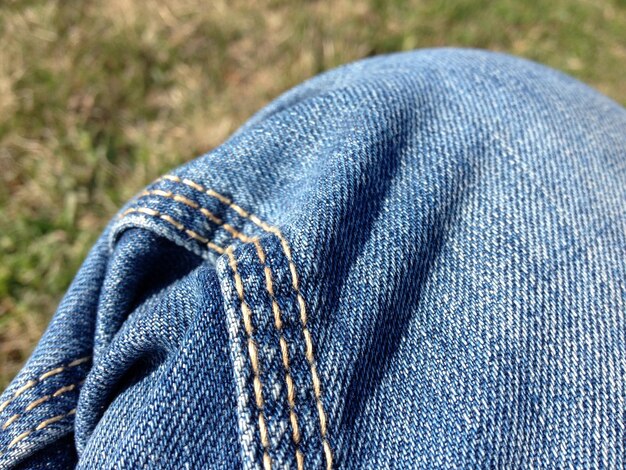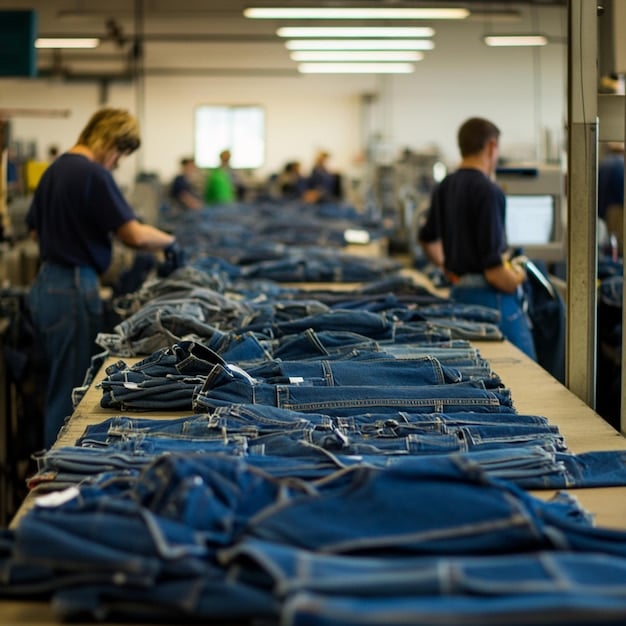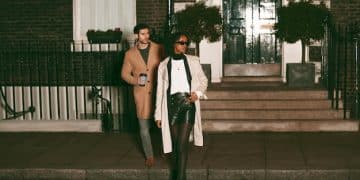The Evolution of Denim: From Workwear to Wardrobe Staple

Anúncios
The journey of denim transcends its humble origins as durable workwear, transforming into an enduring global fashion icon, continually adapting to cultural shifts and design innovations while retaining its universal appeal.
Few fabrics boast a trajectory as remarkable as denim, transitioning from a utilitarian garment for laborers to an indispensable wardrobe staple embraced by countless individuals worldwide. Its story is one of resilience, reinvention, and an uncanny ability to reflect the zeitgeist of every era it has touched.
Anúncios
The Humble Beginnings: Workwear and Durability
The origins of denim are rooted in practicality and necessity. This sturdy cotton twill fabric emerged to meet the demands of strenuous labor, offering unparalleled durability and resistance to wear and tear. Its inherent strength made it the ideal choice for outfits designed to withstand the rigors of physical work.
Before it became a fashion statement, denim was the uniform of the working class. Miners, farmers, factory workers, and cowboys relied on its robust nature, valuing its longevity over its aesthetic appeal. This foundational period established denim’s reputation for resilience, a quality that continues to define it even today.
From Nîmes to Genoa: Tracing Denim’s Etymology
The very name “denim” offers a clue to its European heritage. The term is believed to be derived from “serge de Nîmes,” referring to a twilled fabric from Nîmes, France. Meanwhile, the word “jeans” originates from “Genes,” the French word for Genoa, Italy, where a similar cotton corduroy fabric, known as “jean,” was produced.
Anúncios
This dual etymology highlights the fabric’s long and international history, predating its widespread recognition in the American West. The initial iterations of denim were far removed from the indigo-dyed pants we recognize today, often appearing in various colors and weaves before blue became the dominant hue.
- Nîmes, France: Renowned for “serge de Nîmes,” a robust twilled fabric.
- Genoa, Italy: Produced “jean,” a cotton corduroy often used for sailor’s clothes.
- Indigo Dye: The characteristic blue color became popular due to its resistance to fading and ability to hide stains.
- Durability Principles: The core appeal was its strength and longevity for demanding professions.
The strategic use of indigo dye was a game-changer, not just for aesthetics but also for practical reasons. Indigo was readily available, produced a deep, uniform color, and was known for its fade-resistant properties, concealing dirt and scuffs — an invaluable feature for those working in harsh conditions. This combination of strength and smart coloring cemented denim’s place as the ultimate workwear fabric.
This early phase of denim’s history laid the groundwork for its future. The emphasis was purely on function, a stark contrast to its later role as a symbol of style and rebellion. Understanding this hardworking past is crucial to appreciating the extraordinary transformation that followed and how it maintained its core appeal even as its purpose shifted dramatically.
The American Dream: Levi Strauss and the Gold Rush Era
The story of denim truly takes root in America, particularly during the California Gold Rush of the mid-19th century. This era brought together two key figures whose collaboration would forever change the course of casual wear: Levi Strauss, a German immigrant savvy in entrepreneurship, and Jacob Davis, a tailor with a brilliant, practical innovation.
Levi Strauss arrived in San Francisco in 1853, initially selling dry goods to gold miners. His business acumen was keen, but it was the partnership with Jacob Davis that revolutionized the concept of durable trousers.
The Rivet Revolution: Jacob Davis’s Innovation
Jacob Davis, a Reno-based tailor, noticed a persistent problem with the work pants he supplied to laborers: they often ripped at stress points like pockets and fly seams. In 1871, he devised a simple yet ingenious solution: reinforcing these critical areas with metal rivets.
Recognizing the potential of his invention but lacking the funds to patent it, Davis approached Levi Strauss, his fabric supplier, suggesting a partnership. Strauss immediately grasped the significance of Davis’s idea, and on May 20, 1873, they received U.S. Patent No. 139,121 for “Improvement in Fastening Pocket-Openings.” This patent marked the official birth of the riveted denim “waist overalls,” later known as blue jeans.
The introduction of rivets significantly extended the lifespan of work pants, making them even more indispensable for miners and various manual laborers. This innovation wasn’t about style; it was about enhancing durability, directly addressing a pain point for its target consumers.
- 1853: Levi Strauss arrives in San Francisco, supplying dry goods.
- 1871: Jacob Davis invents rivet reinforcement for work pants.
- 1873: Strauss and Davis patent riveted trousers, creating the first true blue jeans.
- Practicality Reigns: The focus was entirely on functionality and longevity for rugged work.
The early Levi’s jeans, often referred to as “waist overalls,” were designed for maximum utility. They featured deep pockets for tools, a hammer loop, and the signature copper rivets. The indigo color, already favored for workwear, became synonymous with these durable garments. It was this unwavering commitment to utility and robust construction that endeared early denim jeans to the American laborer, setting the stage for their eventual leap from the workplace to mainstream culture.

The partnership between Strauss and Davis transcended a simple business transaction; it forged a legacy. Their invention became an icon of American industry and ingenuity, symbolizing the spirit of the frontier and the resilience of the working class. This foundational period cemented denim’s practical identity, a trait that remains integral to its narrative, even as it ascended the ranks of fashion.
Denim’s Hollywood Rebellion: From Workwear to Cultural Symbol
The mid-20th century witnessed a dramatic shift in denim’s public perception. No longer confined to ranches and factories, blue jeans began to appear on the silver screen, transforming from utilitarian garb into a powerful symbol of rebellion, youth, and counter-culture. Hollywood played an undeniable role in this sartorial revolution.
Movie stars, embodying a new kind of cool and defiance, donned denim, inadvertently (or intentionally) granting it an allure that resonated deeply with post-war generations. This transition was pivotal, marking denim’s definitive move from the realm of pure function to that of profound cultural significance.
Icons of Disobedience: James Dean and Marlon Brando
Two figures stand out as primary catalysts in denim’s cultural ascension: James Dean and Marlon Brando. Their iconic roles, often portraying brooding, misunderstood rebels, inextricably linked blue jeans with a youthful spirit of nonconformity.
In 1953, Marlon Brando’s portrayal of Johnny Strabler in “The Wild One” depicted a motorcycle gang leader in a leather jacket and classic blue jeans. The film quickly became controversial, with some believing it glorified delinquency. However, for young audiences, Brando’s rugged, denim-clad image was an emblem of freedom and defiance against societal norms.
- 1953: Marlon Brando’s “The Wild One” popularizes denim as rebellious wear.
- 1955: James Dean’s “Rebel Without a Cause” solidifies denim’s youth appeal.
- Symbol of Freedom: Jeans represented a break from traditional, formal attire.
- Counter-Culture Embrace: Denim became a uniform for burgeoning youth movements.
Two years later, James Dean cemented denim’s legendary status in “Rebel Without a Cause” (1955). His character, Jim Stark, sported a red jacket, white t-shirt, and unmistakable blue jeans, creating an enduring image of alienated youth. Dean’s untimely death further mythologized his persona, and with it, the blue jeans he wore. These films, despite their controversial reception by some elders, undeniably propelled denim into the mainstream consciousness as an emblem of cool and individuality.
The shift was evident in how denim was perceived; it moved from being strictly functional to having an emotional and psychological resonance. This newfound association, fueled by popular media, paved the way for denim to transcend its initial purpose and become a staple in casual fashion, setting the stage for its global domination.
The Hippie Movement and Beyond: Personalization and Expression
As the 1960s ushered in an era of social and political upheaval, denim found another powerful voice: the hippie movement. This period transformed blue jeans from a symbol of quiet rebellion into a vibrant canvas for self-expression and anti-establishment ideals.
The counter-culture embraced denim’s democratic nature, rejecting the formality and materialism of previous generations. Jeans became an intentional statement of peace, freedom, and individuality, often adorned with personal touches that bespoke the wearer’s unique identity.
Embracing Individuality: Patches, Embroidery, and Bell Bottoms
The standardized uniformity of earlier denim gave way to an explosion of personalization. Hippies and young people hand-decorated their jeans with patches, embroidery, paint, and tie-dye, turning each pair into a unique work of art. This DIY approach celebrated creativity and rejected mass-produced fashion.
The silhouette also evolved dramatically. Bell-bottom jeans, with their wide flares at the ankle, became a defining characteristic of the era, complementing the free-flowing aesthetic favored by the movement. This style not only reflected a broader rejection of constrained fashion but also facilitated ease of movement, aligning with a more relaxed and fluid lifestyle.
- 1960s-1970s: Denim becomes a staple of the counter-culture.
- Personalization: Patches, embroidery, paint, and tie-dye make each pair unique.
- Bell Bottoms: Iconic silhouette of the era, reflecting freedom and fluidity.
- Anti-Establishment Symbol: Denim represented a rejection of mainstream formality.
Denim’s versatility allowed it to adapt to this new role seamlessly. Its sturdy canvas proved perfect for artistic embellishment, allowing wearers to literally wear their beliefs and affiliations. From peace signs to floral motifs, every stitch and patch told a story, making each pair of jeans a personal manifesto.
This phase was crucial for denim’s evolution, proving its adaptability and its capacity to transcend mere clothing status. It became a medium for artistic expression and a symbol of a generation’s hopes and dreams. The legacy of personalization from this era continues to influence denim trends, with distressed finishes and unique embellishments remaining popular design elements today.
The 1980s and 90s: Designer Denim and Global Dominance
The latter half of the 20th century saw denim shed its purely counter-cultural image and ascend to the lofty heights of high fashion and global commerce. The 1980s heralded the era of “designer denim,” transforming blue jeans from a casual staple into a luxury item, while the 1990s consolidated its status as an undeniable wardrobe essential across all demographics.
This period introduced new cuts, washes, and branding, pushing denim into department stores and onto international runways. Advertising campaigns featuring supermodels and celebrities played a crucial role in cementing its aspirational appeal.
From Casual to Couture: The Rise of Designer Labels
Brands like Calvin Klein, Guess, and Jordache took denim to unprecedented levels of sophistication and sex appeal in the 1980s. Their provocative advertising campaigns, often featuring young, edgy models like Brooke Shields for Calvin Klein, made designer jeans a must-have item. Marketing focused not just on the product but on a lifestyle, transforming denim into a symbol of status and desirability.
The “designer” label brought with it higher price tags and a perception of exclusivity. New washes emerged, such as acid wash and stonewash, providing distinct aesthetics beyond the traditional dark indigo. High-waisted, tapered leg styles became dominant, reflecting the decade’s fashion trends.
- 1980s: Emergence of designer denim (Calvin Klein, Guess) and aspirational branding.
- New Washes: Acid wash and stonewash gain popularity.
- 1990s: Denim becomes a mainstream wardrobe essential across generations.
- Global Reach: Denim solidifies its presence in fashion markets worldwide.
By the 1990s, denim’s global domination was complete. From grunge-inspired ripped jeans to minimalist, straight-leg cuts, denim found a place in every subculture and fashion niche. Brands like Levi’s reasserted their classic appeal, while new players continued to innovate with fits and finishes.
The 90s celebrated versatility and comfort. Baggy jeans, overalls, and distressed denim were all part of the sartorial landscape, indicating denim’s ability to adapt to diverse style preferences from hip-hop to grunge to preppy. This era cemented denim’s universal appeal, solidifying its position as a go-to fabric for nearly every occasion, cementing its global identity beyond merely American style.
The 21st Century: Athleisure, Sustainability, and Beyond
As the 21st century unfolded, denim continued its remarkable evolution, adapting to new consumer demands for comfort, sustainability, and technological integration. The rise of athleisure, a growing environmental consciousness, and advancements in textile technology have all profoundly impacted the trajectory of denim.
Today, denim is not just about the classic blue jean; it encompasses a vast array of styles, fabrics, and production methods, reflecting a more informed and diverse global consumer base.
Comfort and Conscience: The Rise of Stretch and Sustainable Denim
One of the most significant shifts has been the incorporation of stretch fibers into denim. The demand for comfort, fueled by the athleisure trend, led to the development of denim blends that offer greater flexibility and ease of movement without sacrificing the authentic look of jeans. This innovation has made denim suitable for a wider range of activities, blurring the lines between activewear and casual wear.
Parallel to the comfort revolution, sustainability has become a paramount concern. The denim industry, historically water-intensive and chemically reliant, has faced increasing pressure to adopt eco-friendlier practices. This has led to the emergence of “sustainable denim,” leveraging technologies that reduce water consumption, minimize chemical use, and utilize recycled or organic materials.

- Athleisure Integration: Stretch denim offers comfort and flexibility for active lifestyles.
- Sustainable Practices: Focus on reducing water, chemicals, and promoting recycled materials.
- Technological Advancements: Innovations in laser finishing and ozone washing.
- Consumer Awareness: Growing demand for ethically produced and environmentally friendly options.
Innovations in finishing processes, such as laser distressing and ozone washing, aim to achieve worn-in effects with less water and fewer chemicals compared to traditional methods. Brands are also exploring denim alternatives like hemp and Tencel, further pushing the boundaries of what denim can be.
This modern era of denim is characterized by a conscientious approach to both production and consumption. Consumers are increasingly seeking transparency and ethical practices from their favorite brands, driving the industry towards a more responsible future. The emphasis is on blending style with environmental stewardship, ensuring denim remains relevant and responsible in a changing world.
The Future of Denim: Innovation and Enduring Appeal
The journey of denim is far from over. As we look ahead, the future of this iconic fabric appears to be shaped by continued innovation in materials, manufacturing processes, and design, all while grappling with the evolving demands of a global market.
The quest for enhanced functionality, unparalleled comfort, and a truly circular production model will likely define the next chapters in denim’s storied history. Its enduring appeal lies in its remarkable adaptability and its ability to continually reinvent itself.
Smart Denim, Circularity, and Hyper-Personalization
Imagine denim that charges your phone, monitors your vital signs, or even changes color with a touch of a button – “smart denim” is no longer confined to science fiction. Textile technology is rapidly advancing, paving the way for denim integrated with wearable tech functionalities. While still nascent, this frontier promises denim that is not just fashionable but also intelligently interactive.
Circularity, the concept of designing out waste and pollution, keeping products and materials in use, and regenerating natural systems, will become increasingly critical. The denim industry is already investing heavily in recycling programs, creating denim from discarded jeans, and designing products for easier end-of-life recycling. The goal is to move from a linear “take-make-dispose” model to a regenerative one.
- Smart Textiles: Integration of technology for enhanced functionality.
- Circular Economy: Focus on recycling, upcycling, and waste reduction in production.
- Hyper-Personalization: Mass customization and bespoke denim experiences.
- Sustainable Sourcing: Greater emphasis on organic, recycled, and alternative fibers.
Hyper-personalization is another trend on the horizon. Beyond simply choosing a size or wash, consumers may soon have even greater control over the design, fit, and features of their denim, facilitated by advanced manufacturing techniques like 3D weaving and on-demand production. This allows for truly unique pieces tailored to individual preferences and body types.
Furthermore, sustainable sourcing will evolve beyond current practices. Expect to see broader adoption of regenerative farming for cotton, alternative fibers like industrial hemp grown with minimal environmental impact, and advancements in dyeing techniques that are entirely waterless or utilize natural pigments. The future of denim is not just about looking good, but about doing good – for the planet and its people.
Ultimately, denim’s journey from a rough work garment to a global fashion staple is a testament to its inherent versatility and timeless appeal. Its future will continue to be shaped by innovation, consumer values, and a relentless pursuit of both style and substance, ensuring its place as an undisputed cornerstone of modern wardrobes.
| Key Milestones | Brief Description |
|---|---|
| 👷 Workwear Origin | Started as durable clothing for miners and laborers in the 19th century. |
| 🎬 Hollywood Influence | James Dean and Marlon Brando transformed denim into a symbol of youth rebellion. |
| ☮️ Counter-Culture Canvas | Hippies personalized jeans with patches and embroidery, reflecting individuality. |
| 🌱 Sustainable Future | Modern denim focuses on eco-friendly production and circularity to reduce impact. |
Frequently Asked Questions About Denim’s Evolution
Denim was chosen for workwear due to its exceptional durability and resistance to wear and tear. Its sturdy twill weave made it ideal for demanding physical labor, providing longevity and protection that other fabrics couldn’t offer, laying the foundation for its widespread adoption in various industries.
James Dean and Marlon Brando popularized denim by wearing it in iconic rebellious roles in films like “Rebel Without a Cause” and “The Wild One.” Their portrayal of defiant, cool characters linked blue jeans with youth culture and nonconformity, transforming them into a powerful fashion statement beyond work attire.
“Designer denim” refers to premium jeans produced by high-end fashion brands, emerging prominently in the 1980s. Labels like Calvin Klein and Guess elevated denim from a utilitarian item to a fashion luxury, often using provocative advertising to create aspirational appeal and higher price points.
Sustainability has significantly impacted modern denim production by driving innovation in eco-friendly practices. This includes reducing water usage through laser and ozone washing, using organic and recycled cotton, and minimizing chemical treatments. Brands are increasingly focusing on circularity to create a more environmentally responsible industry.
Future denim trends are expected to include smart textiles with integrated technology, further advancements in circular economy practices like denim-to-denim recycling, and hyper-personalization for bespoke fits and designs. Greater emphasis on sustainable raw materials like regenerative cotton and alternative fibers will also be key drivers.
Conclusion
The journey of denim from robust workwear to a ubiquitous wardrobe staple is a compelling narrative of adaptation, innovation, and cultural resonance. What began as a practical solution for laborers has transformed into a canvas for rebellion, a symbol of self-expression, and a testament to enduring style. As the industry moves towards greater sustainability and technological integration, denim continues to prove its unparalleled versatility, promising to remain a cornerstone of fashion for generations to come, continually reflecting and shaping our collective identity.





